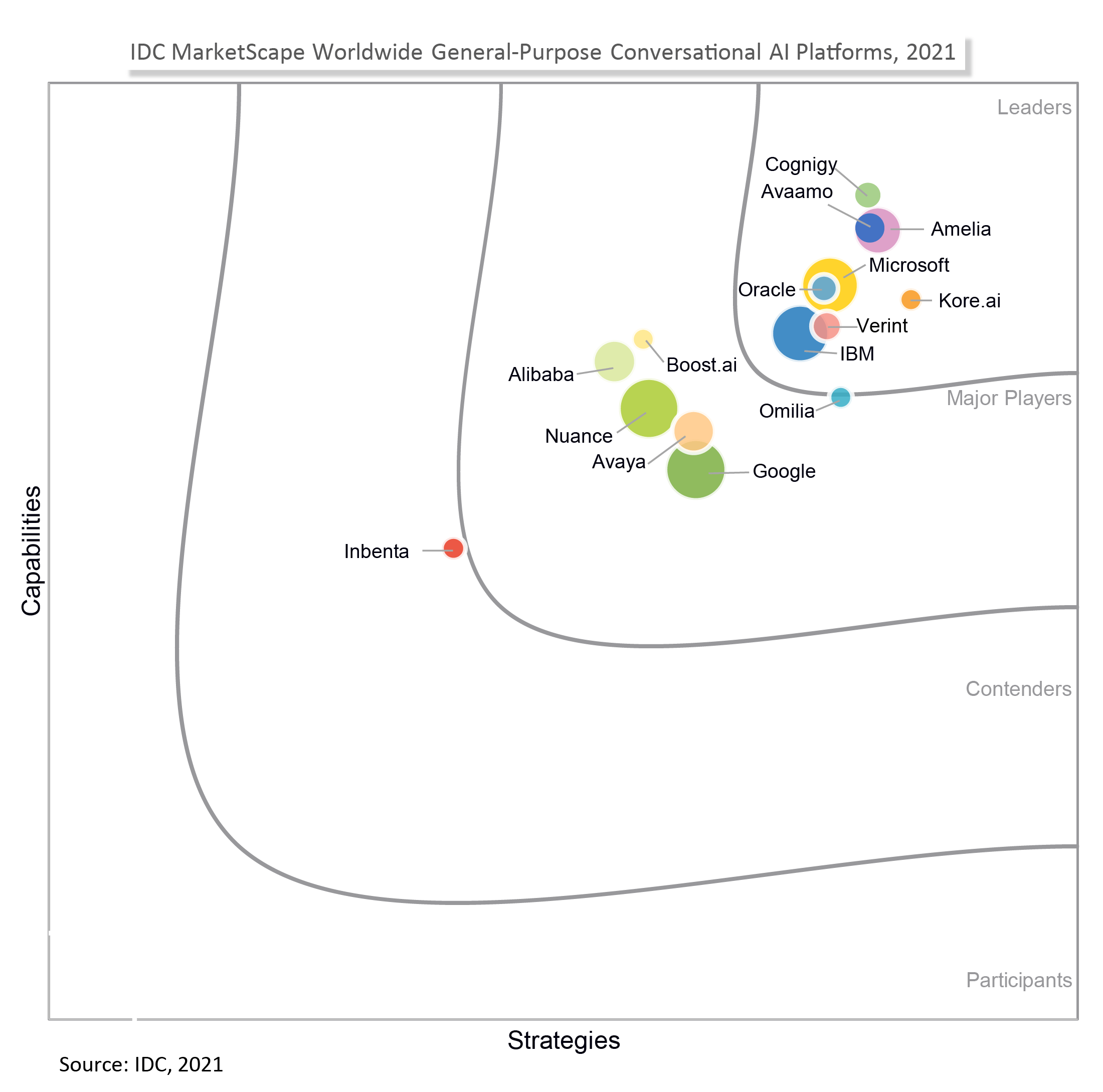
25 Oct Why Avaamo is recognized as a Leader
Avaamo has recently been named as a Leader in the IDC MarketScape: “Worldwide General-Purpose Conversational AI Platforms 2021 Vendor Assessment”. This is a recognition of the five years we spent painstakingly building a conversational platform uniquely integrating tooling, data science, language models and enterprise connectors, enabling enterprise customers to deploy conversational applications in weeks.
Chatbot to Conversational AI – A Short History
The Facebook announcement in 2016 heralded the beginning of natural language interfaces called “chatbots” constructed using rules that encourage canned, linear-driven interactions. This approach failed quickly with 15 minute “Bot companies” cashing in on the hype. Users expecting an intelligent conversation started abandoning chatbots in droves.
The enterprise market followed the craze with its own initial run of chatbots. They quickly figured out that the use-cases such as Employee Service Desk, Patient Self-Service, Supplier Order Management needed a different approach. They needed sophisticated platforms that supported multi-turn conversations, omni-channel support, integration into systems of record and exacting security and compliance requirements.
They turned to conversational AI platforms like Avaamo. True advancements were needed in combining a variety of emerging technologies, from speech synthesis to natural language understanding (NLU), machine learning, and voice telephony. All combined these technologies could execute judgement intensive tasks that were typically done by Human agents. This trend only accelerated with the pandemic.
Conversational AI evolves with remote work
Departmental chatbot vs Conversational AI platform
The remote workplace forced CIO’s and Line of Business executives to prioritize self-service that delivered cost and automation benefits. This change required a broad-based enterprise-ready platform that would satisfy multiple departments, execute disparate use cases and integrate into existing systems. Successful organizations began adopting a mindset of common and consistent AI/ML infrastructure, language models and continuous learning. They demanded adaptable software that delivered on the promise of self-service.
Conversational AI goes multilingual
As adoption of Conversational AI went global, language became the pivotal driver for adoption of self-service initiatives. For the last 40 years globalization of software based on the “language type” primarily consisted of supporting double byte characters. Going multilingual was a formality. Conversations, however, were different. Nuances, accents, or colloquialisms all became a part of the Natural Language Understanding requirements. Supporting Swiss German was a bit different from standard German. Avaamo broke through the multilingual barrier by anticipating this move and spent years building a language engine that supports 70+ languages — making global rollouts a cinch for multinational enterprises.
Avaamo has developed very strong natural language processing capabilities as well as speech recognition capabilities for deploying conversational AI applications across a variety of text and voice-based channels. Its multilingual capabilities include over 70 languages, including hybrid languages.
Avaamo has developed very strong natural language processing capabilities as well as speech recognition capabilities for deploying conversational AI applications across a variety of text and voice-based channels. Its multilingual capabilities include over 70 languages, including hybrid languages.
– IDC Report on General Purpose Conversational Platforms 2021
Omni channel rules!
Enterprises started requesting multi-channel support due to the remote workplace shift. Avaamo had already moved ahead building out-of-the- box omni channel capabilities. In plain terms, this means a user can hop from their desktop to their phone and then continue with SMS, all while having the same experience the whole way through.
Avaamo knits MSFT Teams, Slack, employee portals, text, voice and legacy IVR systems into a ubiquitous omni channel experience, recognizing and responding to the user irrespective of channel. Whether it was a frenzied employee calling or texting/messaging IT support from his home office or a frustrated supplier working from the coffee shop to getting his invoices approved; omni channel support became the pixie dust that led to successful self-service deployments.
Avaamo supports a wide range of digital and voice-based channels out of the box, including phone, SIP, text messaging/SMS, rich web chat, email, Facebook Messenger, WhatsApp, Slack, and Microsoft Teams.
Avaamo supports a wide range of digital and voice-based channels out of the box, including phone, SIP, text messaging/SMS, rich web chat, email, Facebook Messenger, WhatsApp, Slack, and Microsoft Teams.
– IDC Report on General Purpose Conversational Platforms 2021
Low Code/No Code matters
Our internal research has revealed that 40% of Conversational AI projects fail due to the inability of software tools to keep up with the constant changes of fast moving businesses. The questions for us were:
How do we do this without an army of data science and machine learning engineers?
How do we apply low code/no code principles to conversational applications?
What we came up with was the concept of Avaamo Skills. Much like how a human develops a “skill” to listen, understand, and resolve a query, Avaamo “skills” replicate this capability with AI.
For example, a request for account access is a very common IT support query: “Please reset my password.” A human agent has handled hundreds of these queries and knows exactly what questions to ask to quickly triage the problem and/or initiate the appropriate workflow. It’s a skill learned from processing hundreds of requests.
How low code/no code works using an Avaamo AI Skill
An avaamo skill decomposes this innate human skill into AI components:
1) Prepackaged intents that enable parsing different variations of the user request.
2) Language libraries that can understand thousands of words and phrases to service the query in multiple languages and accents.
3) Pre-packaged training datasets gleaned from processing millions of requests coupled with workflows and integration to IT support systems — all to resolve the query.
These components are packaged into a skill designated: “Request for Account Access”. Developers can drag and drop this “Avaamo Skill” to get going quickly. They can deploy versatile virtual assistants that have scores of “skills” in enterprise environments cheaper, better, and faster to accelerate time-to value.
The Avaamo Conversational AI platform, includes a visual drag-and-drop interface for building integrated workflows In addition to its own developer and low-code tools, Avaamo also offers a skill store where customers can choose from thousands of prebuilt skills provided by Avaamo and its partners.
The Avaamo Conversational AI platform, includes a visual drag-and-drop interface for building integrated workflows In addition to its own developer and low-code tools, Avaamo also offers a skill store where customers can choose from thousands of prebuilt skills provided by Avaamo and its partners.
– IDC Report on General Purpose Conversational Platforms 2021
The future: enterprises move beyond the screen
We architected Avaamo from the ground up for this kind of future. A future where users talk more than they type . A future where zero call waiting is the norm. A future where increasingly intelligent virtual assistants will replace “press 2 for schedule an appointment” or “press 1 to talk to IT support.”
Employee and customer experience with self-service automation has become a driving force behind the adoption of Conversational AI. Avaamo continues to resolve 40% of IT support issues without human intervention for dozens of enterprises, services employee requests for 500K users in 20 countries on MSFT teams, and handles thousands of phone calls routed from conventional IVR systems for Penske leasing handled without human intervention.
We receive this kind of recognition as a category leader entirely because of the hard work of our team and the incredible support of our customers and partners. Its still “Day 1” in the category and we continue to build keeping our customer needs in mind.



